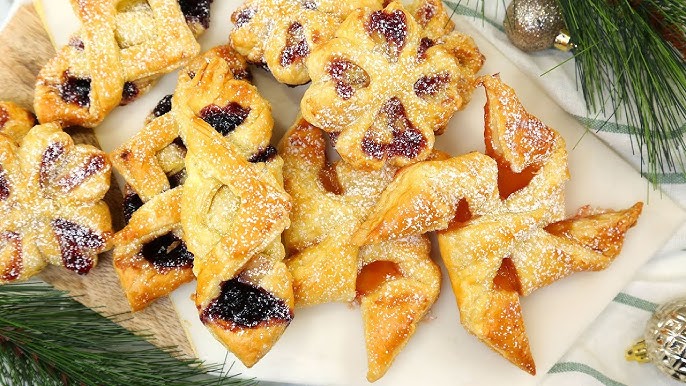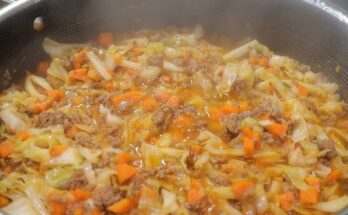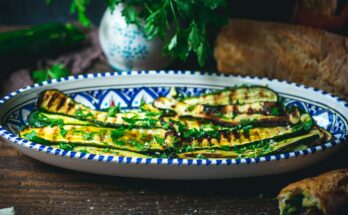Puff Pastry Recipe: Puff pastry is a delicate, flaky pastry made from layers of dough and butter folded together to create a light, airy texture. It’s widely used in both sweet and savory recipes, ranging from classic croissants to crispy cheese straws.
Why Make Puff Pastry at Home?
Homemade puff pastry offers unbeatable freshness and flavor. While store-bought versions are convenient, making it yourself allows you to control the quality of ingredients, skip preservatives, and customize it for specific recipes.
Uses of Puff Pastry in Cooking
Puff pastry is a versatile ingredient that can elevate both desserts and appetizers. Popular recipes include turnovers, tarts, palmiers, pot pies, and savory puffs. Whether you want a rich dessert or a crowd-pleasing party snack, puff pastry is your go-to choice.
Ingredients Needed for Puff Pastry
Key Ingredients
To make puff pastry, you’ll need just four simple ingredients:
- Flour: Use all-purpose flour for the best balance between structure and flakiness.
- Butter: High-quality unsalted butter is key for achieving that rich, flaky texture.
- Water: Cold water helps keep the butter from melting during the process.
- Salt: A pinch of salt enhances the flavor of the dough.
Tips for Choosing Quality Ingredients
- Opt for European-style butter, which has a higher fat content, to create flakier layers.
- Always use chilled ingredients to prevent the butter from softening too quickly.
- If possible, sift your flour to avoid lumps in the dough.
Equipment Required
Essential Tools
- Rolling Pin: A sturdy, even rolling pin is crucial for rolling out the dough uniformly.
- Baking Sheet: Use a flat baking sheet to bake your pastry evenly.
- Parchment Paper: Prevents sticking and makes cleanup easier.
- Knife or Dough Cutter: Use for precise cuts and clean edges.
Optional Equipment for Precision
- A pastry scraper can help handle the dough without adding excess heat.
- A ruler or measuring tape is useful for maintaining even folds and cuts.
Preparing the Dough
Measuring and Mixing Ingredients
Start by combining the flour and salt in a mixing bowl. Gradually add cold water, stirring gently until a rough dough forms. Avoid overmixing to keep the dough light.
Achieving the Perfect Dough Texture
The dough should be slightly sticky but not wet. Add a small amount of flour if it feels too moist or a few drops of water if it’s too dry.
Resting the Dough for Best Results
Wrap the dough in plastic wrap and refrigerate it for at least 30 minutes. This allows the gluten to relax, making the dough easier to roll and fold.
Laminating the Dough
What is Laminating in Baking?
Laminating involves folding butter into the dough multiple times to create layers. This is the key technique for achieving the signature flakiness of puff pastry.
Rolling and Folding Technique
- Roll the dough into a rectangle.
- Place a sheet of butter (flattened into a square) in the center.
- Fold the dough over the butter like an envelope.
- Roll it out again and fold it into thirds. This is one “turn.”
- Repeat this rolling and folding process 4–6 times, chilling the dough for 30 minutes between each turn.
Rest Periods Between Laminations
Allowing the dough to rest in the fridge between turns is essential. This keeps the butter cold, which helps maintain distinct layers during baking.
Shaping and Cutting the Puff Pastry
How to Shape Puff Pastry for Recipes
Once your laminated dough is ready, it’s time to shape it based on the recipe you want to prepare. First, roll the dough to your desired thickness, usually around 1/8 inch. The thickness plays a significant role in how the pastry bakes; thinner sheets yield crispier results, while thicker ones offer a fluffier bite.
When shaping for recipes like tarts or pies, ensure you handle the dough gently to maintain the butter layers. Use cookie cutters or molds for consistent shapes if you’re making small pastries or appetizers.
Cutting Techniques for Perfect Layers
Cutting puff pastry requires precision. Use a sharp knife or pastry cutter to ensure clean cuts that won’t squish the layers. For recipes requiring symmetrical pieces, like turnovers, measure the dimensions carefully before slicing. Always make your cuts in one swift motion to avoid tearing the dough, which can ruin the rise.
Pro tip: Chill the dough for a few minutes after cutting to firm it up before baking. This small step ensures your edges puff up evenly.
Baking Puff Pastry
Preheating the Oven
Puff pastry needs an evenly heated oven to rise properly. Preheat your oven to 400°F (200°C) for most recipes. A hot oven is crucial to create the steam needed for the pastry to puff up.
Baking Tips for a Crispy Texture
- Place your pastries on a parchment-lined baking sheet to prevent sticking.
- Avoid overcrowding the tray; leave enough space for the pastries to expand.
- If you want extra golden tops, brush your pastry with an egg wash (a mixture of beaten egg and water or milk) just before baking.
Common Baking Mistakes to Avoid
- Butter leakage: This happens if the dough isn’t chilled enough. Always ensure your dough is cold before baking.
- Uneven puffing: This often results from inconsistent rolling. Be sure your dough is evenly thick before baking.
- Underbaking: Puff pastry should be golden and crisp. If it looks pale or soggy, give it a few more minutes in the oven.
Puff Pastry Recipes You Can Try
Sweet Recipes
- Cream-Filled Puff Pastries: Pipe your favorite whipped cream or custard into baked puff pastry shells for an elegant dessert. Top with powdered sugar for a finishing touch.
- Fruit Turnovers: Fill puff pastry squares with fruit preserves, fold them into triangles, seal the edges, and bake until golden.
Savory Recipes
- Cheese Straws: Roll out your puff pastry, sprinkle grated cheese and a touch of paprika, then twist into strips before baking. These make a perfect snack!
- Sausage Rolls: Wrap seasoned sausage meat in puff pastry and bake for a crowd-pleasing appetizer or snack.
Troubleshooting Puff Pastry
Common Issues with Puff Pastry
- Sticky Dough: If the dough sticks while rolling, chill it again and lightly flour the surface.
- Butter Melting: This indicates the dough wasn’t chilled enough between laminations. Always refrigerate your dough if it feels soft.
- Flat Pastry: If your pastry doesn’t rise, it may be due to improper folding or overworking the dough.
How to Fix Imperfect Layers or Dough
If your layers aren’t as distinct as you’d like, try giving the dough an extra “turn” (fold). Keep in mind, once baked, puff pastry often hides minor flaws, so don’t stress too much!
Tips for Storing Puff Pastry
Storing Unbaked Dough
Wrap unbaked puff pastry tightly in plastic wrap and store it in the refrigerator for up to 3 days. For longer storage, freeze the dough by wrapping it in a double layer of plastic wrap followed by foil. It can last up to 2 months in the freezer.
Storing Baked Puff Pastry
Baked puff pastry is best eaten fresh, but you can store leftovers in an airtight container at room temperature for up to 2 days. To refresh the crispiness, reheat it in the oven at 350°F (175°C) for a few minutes.
Benefits of Homemade Puff Pastry
Cost Effectiveness
While store-bought puff pastry can be pricey, making it at home is surprisingly economical. With just a few ingredients, you can make a large batch to freeze and use as needed.
Taste and Customization
Homemade puff pastry offers a rich, buttery flavor that’s hard to beat. Plus, you can tweak the recipe to suit your preferences—like adding herbs, spices, or even a touch of sugar for sweet recipes.
FAQs about Puff Pastry Recipe
1. What ingredients are needed for puff pastry?
To make puff pastry, you need flour, butter, salt, and water. The key to a successful puff pastry is using cold butter and ice water to keep the dough cool during preparation.
2. How long does it take to make puff pastry from scratch?
Making puff pastry from scratch typically requires about 15 minutes of active preparation time and several hours of chilling and resting. This allows the layers to set properly for optimal puffiness.
3. Can I use margarine instead of butter?
While margarine can be used, butter is highly recommended for the best flavor and texture. Margarine may alter the taste and may not provide the same flakiness as butter.
4. Why does my puff pastry not rise properly?
Improper rising can be due to several factors: the butter may have been too soft, the dough wasn’t chilled sufficiently, or the oven wasn’t hot enough. Ensure your butter is cold and your oven is preheated to the right temperature.
5. Is puff pastry vegan?
Traditional puff pastry is not vegan as it contains butter. However, there are vegan alternatives using plant-based butters or oils.
6. How can I store leftover puff pastry?
Leftover puff pastry can be wrapped tightly in plastic wrap and stored in the refrigerator for up to 3 days. For longer storage, you can freeze it for up to 2 months.
7. Can puff pastry be made gluten-free?
Yes, puff pastry can be made gluten-free by using suitable gluten-free flour. Keep in mind that the texture might differ from traditional puff pastry.
8. What are some common mistakes when making puff pastry?
Common mistakes include not chilling the dough long enough, rolling the dough too thin, and not using enough butter, which can prevent the pastry from rising correctly.
Conclusion
Making puff pastry from scratch might seem intimidating, but with this step-by-step guide, it’s absolutely achievable. The key is patience, precision, and lots of chilling time. Whether you’re making savory appetizers or sweet desserts, homemade puff pastry will take your baking game to the next level. So, why not roll up your sleeves and give it a try? Trust me, the flaky, buttery results are worth every bit of effort.



